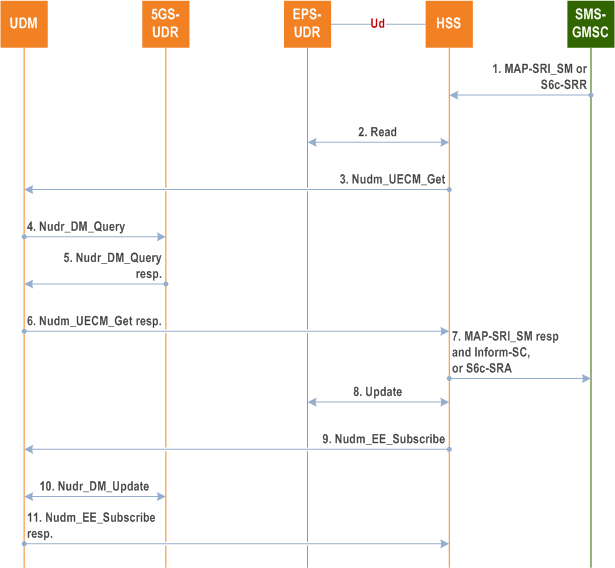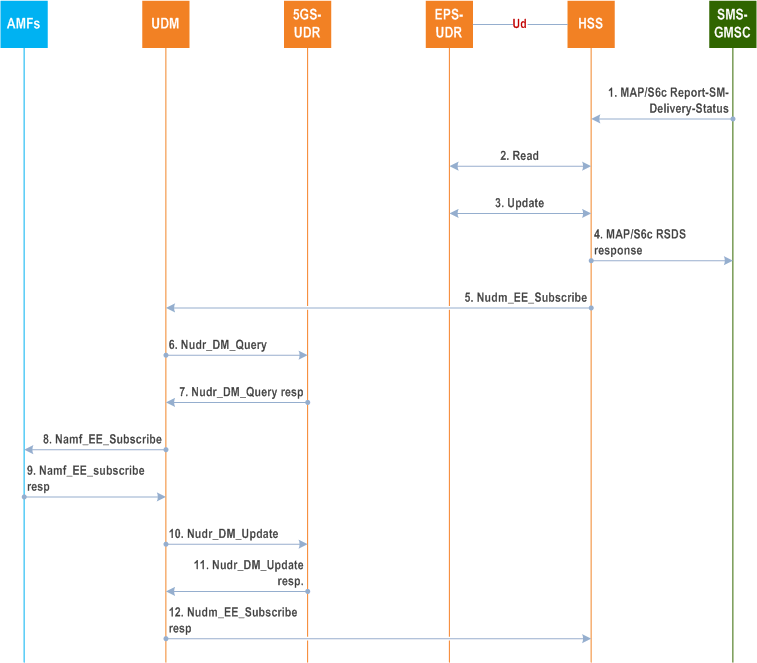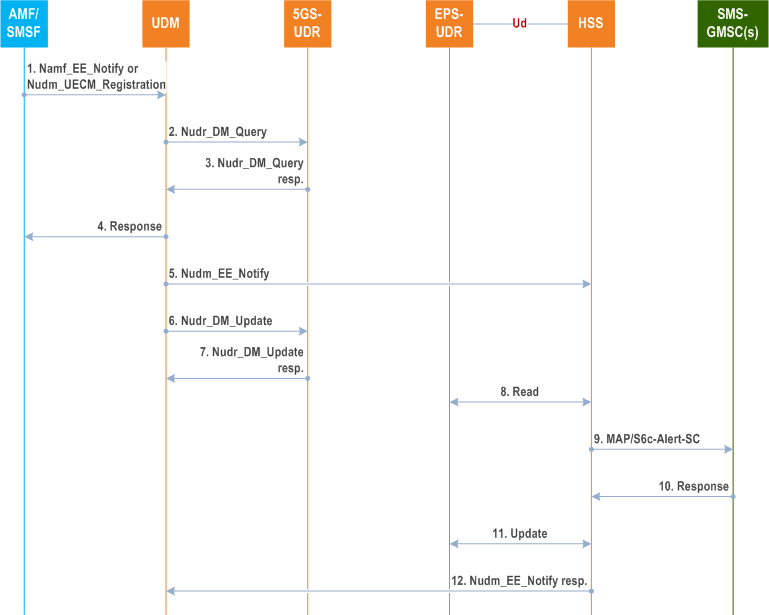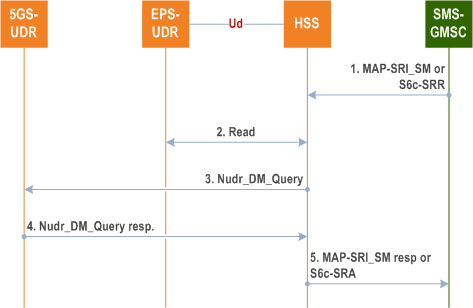Content for TS 23.632 Word version: 18.4.0
5.5 SMS Support
5.5.1 General
5.5.2 MT-SMS Routing Information Retrieval
5.5.3 MT-SMS Delivery Failure
5.5.4 SMS Alerting
5.5.5 MT-SMS Routing Information Retrieval Over Nudr
...
...
5.5 SMS Support p. 32
5.5.1 General p. 32
Potential MT-SMS target nodes in the EPS are the MME/MSC and the SGSN registered at the HSS, while in 5GS MT-SMS target nodes are the 3GPP-SMSF and the Non3GPP-SMSF registered at the UDM. For the role of SMS-Router and IP-SM-GW see TS 23.040.
5.5.2 MT-SMS Routing Information Retrieval p. 32
Figure 5.5.2-1 shows the interaction when the SMS-GMSC retrieves routing information from the HSS for MT-SMS delivery.

Step 1.
The HSS receives a request for routing information from the SMS-GMSC via MAP or S6c.
Step 2.
The HSS queries the EPS-UDR via Ud to read the registered MME/MSC, the registered SGSN, and the UE-not-reachable flags for SMS in MME/MSC, SGSN and UDM.
Step 3.
If the UE-not-reachable flag for SMS in UDM is not set and unless the user is known not to be registered in 5GC, the HSS retrieves the registered SMSF addresses for 3GPP and non-3GPP accesses (if any) from the UDM.
Step 4-5.
The UDM retrieves the requested information from the 5GS-UDR.
Step 6.
The UDM forwards the retrieved addresses to the HSS if any. If the UE is not reachable for MT-SMS in 5GS for any access type (e.g. there is no SMSF registered for the UE or SMSF registration exists but UE is known not to be reachable in 5GS based on URRP flag), the UDM provides a negative response (Absent Subscriber SM) to the HSS.
If SMS over NAS is not allowed for the user in 5GS based on subscription data, e.g. SMS teleservice is not provisioned or SMS is barred, the UDM indicates in the response to the HSS the corresponding error condition.
Step 7.
The HSS returns the relevant MT-SMS target node addresses registered in HSS and/or UDM to the SMS-GMSC and the procedure is terminated.
Otherwise, if there is no MT-SMS target node address registered in HSS nor in UDM, a negative response (Absent Subscriber SM) is sent to the SMS-GMSC and the procedure continues with steps 8 to 11.
Step 8.
The HSS includes the SMSC address to the Message Waiting Data (MWD) stored in the EPS-UDR and informs the SMSC as defined in TS 23.040. The relevant UE-not-reachable flags are set in the EPS-UDR.
If SMS is not allowed for the user in 5GS according to subscription data as indicated in step 6, steps 9 to 11 are not executed so that the HSS does not subscribe to notifications about reachability for SMS in the UDM, and the procedure is terminated.
Step 9.
The HSS subscribes in UDM to be notified when the UE becomes reachable for SMS (i.e. when the UE gets in radio contact with the AMF while an SMSF actually is registered, or when an SMSF gets registered) by using the Nudm_EE_Subscribe service operation (SUPI, UE Reachability for SMS event) as defined in TS 23.502.
Step 10.
The UDM stores the EE-subscription (Reachability for SMS) in the 5G-UDR.
Step 11.
The UDM acknowledges the subscription to the HSS.
5.5.3 MT-SMS Delivery Failure p. 34
Figure 5.5.3-1 shows the interaction when the SMS-GMSC sends Report-SM-Delivery-Status to the HSS.

Step 1.
The HSS receives a Report-SM-Delivery-Status from the SMS-GMSC indicating the MT-SMS target nodes at which MT-SMS delivery was unsuccessful.
Step 2-3.
The HSS reads and updates the Message Waiting Data stored in the EPS-UDR.
Step 4.
The HSS acknowledges the receipt of the delivery status to the SMS-GMSC.
Step 5.
If the UE-not-reachable flag for UDM is set to true, the HSS subscribes to notification on UE-Reachability for SMS at the UDM, using the Nudm_EE_Subscribe service operation as defined in TS 23.502, unless such subscription already exists.
Step 6-7.
The UDM checks that the UE is registered in an AMF and SMSF for 3GPP and non-3GPP accesses. The UDM then queries the 5GS-UDR to see whether the UE-Reachability event has already been subscribed at the registered AMF(s) (i.e. whether URRP-AMF flag is set).
Step 8-9.
If not already subscribed, the UDM subscribes to UE-Reachability notification at the AMF(s) using the Namf_EE service.
Step 10-11.
The UDM stores the received EE-Subscription in the 5GS-UDR and if steps 8-9 were performed, the UDM sets the relevant URRP-AMF flags in the 5GS-UDR.
Step 12.
The UDM acknowledges the subscription to the HSS.
5.5.4 SMS Alerting p. 35
Figure 5.5.4-1 shows the interaction when the UE becomes available.

Step 1.
Steps 8 to 11 are skipped if the HSS has not been notified in step 5.
The UDM receives a Notification from the AMF or an SMSF Registration.
Step 2-3.
The UDM queries the 5GS-UDR to see whether any NF (e.g. the HSS) has subscribed to notifications on UE-reachability for SMS events and/or "UE memory available for SMS".
Step 4.
The UDM acknowledges the message received in step 1.
Step 5.
If the HSS has subscribed to UE reachability for SMS notification and/or "UE memory available for SMS", the UDM notifies the HSS as described in TS 23.502.
Step 6-7.
The UDM updates (clears) the relevant reachability flag. And, if the HSS has been notified in step 5, the UDM also deletes the (one-time) EE-subscriptions of UE reachability for SMS in the 5GS-UDR.
Step 8.
The HSS reads Message Waiting Data from the EPS-UDR.
Step 9-10.
If the notification of "UE memory available for SMS" is received from the UDM, the HSS sends Alert-SC to all SMS-GMSCs stored in the MWD.
Step 11.
The HSS clears the relevant UE-not-reachable flags and the MCEF flag from the EPS-UDR and removes the SMS-GMSCs from the MWD stored in the EPS-UDR if the notification of "UE memory available" is received.
Step 12.
The HSS acknowledges receipt of the Notification to the UDM.
5.5.5 MT-SMS Routing Information Retrieval Over Nudr p. 37
Figure 5.5.5-1 shows the interaction when the SMS-GMSC retrieves routing information from the HSS for MT-SMS delivery when the HSS uses the Nudr SBI.

Step 1.
The HSS receives a request for routing information from the SMS-GMSC via MAP or S6c.
Step 2.
The HSS queries the EPS-UDR via Ud to read the registered MME/MSC, the registered SGSN and the UE-not-reachable flags for MME/MSC, SGSN and UDM.
Step 3-4.
If the UE-not-reachable flag for UDM is not set and unless the user is known not to be registered in 5GC, the HSS retrieves the registered SMSF addresses for 3GPP and non-3GPP accesses (if any) from the 5GS-UDR.
Step 5.
The HSS returns the relevant MT-SMS target node addresses registered in HSS and/or UDM to the SMS-GMSC and the procedure is terminated.
Otherwise, if there is no MT-SMS target node address registered in HSS nor in UDM, a negative response (Absent Subscriber SM) is sent to the SMS-GMSC and the procedure continues with steps 8 to 11 in figure 5.5.2-1.